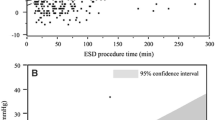Abstract
Background
The authors have reported that carbon dioxide (CO2) insufflation is safe and effective for lengthy endoscopic submucosal dissection (ESD) with the patient under conscious sedation. However, CO2 monitoring has not been assessed to clarify whether partial pressure of carbon dioxide (PCO2) increases during this type of long procedure. This study aimed to monitor CO2 before, during, and after ESD to investigate whether CO2 insufflation is safe for patients receiving a lengthy ESD of early colorectal neoplasia under conscious sedation.
Methods
This study prospectively enrolled 35 consecutive patients who underwent ESD at the National Cancer Center Hospital. Transcutaneous PCO2 (PtcCO2) was measured with a noninvasive sensor before, during, and after ESD for patients under conscious sedation using midazolam.
Results
The mean size of removed lesions was 44 ± 22 mm (range, 15–100 mm). The operation time was 90 ± 100 min (range, 15–600 mm). The dose of midazolam was 5.7 ± 4.0 mg (range, 2–19 mg). The mean PtcCO2 was 41 ± 5 mmHg (range, 33–53 mmHg) before ESD and 44 ± 6 mmHg (range, 32–54 mmHg) afterward. The mean peak PtcCO2 during ESD was 55 ± 7 mmHg (range, 39–78 mmHg), which was significantly higher than before or after ESD (p < 0.0001). However, no complication associated with CO2 insufflation such as CO2 narcosis, gas embolism, or arrhythmia needing treatment was seen in any of the cases.
Conclusions
This study suggests that CO2 insufflation is safe for patients receiving a lengthy colorectal ESD under conscious sedation.



Similar content being viewed by others
References
Hussein AM, Bartram CI, Williams CB (1984) Carbon dioxide insufflation for more comfortable colonoscopy. Gastrointest Endosc 30:68–70
Stevenson GW, Wilson JA, Wilkinson J, Norman G, Goodacre RL (1992) Pain following colonoscopy: elimination with carbon dioxide. Gastrointest Endosc 38:564–567
Bretthauer M, Thiis-Evensen E, Huppertz-Hauss G, Gisselsson L, Grotmol T, Skovlund E, Hoff G (2002) NORCCAP (Norwegian Colorectal Cancer Prevention): a randomized trial to assess the safety and efficacy of carbon dioxide versus air insufflation in colonoscopy. Gut 50:604–607
Church J, Delaney C (2003) Randomized, controlled trial of carbon dioxide insufflation during colonoscopy. Dis Colon Rectum 46:322–326
Bretthauer M, Lynge AB, Thiis-Evensen E, Hoff G, Fausa O, Aabakken L (2005) Carbon dioxide insufflation in colonoscopy: safe and effectiveness in sedated patients. Endoscopy 37:706–709
Saito Y, Uraoka T, Matsuda T, Emura F, Ikehara H, Mashimo Y, Kikuchi T, Fu KI, Sano Y, Saito D (2007) Endoscopic treatment of large superficial colorectal tumors: a case series of 200 endoscopic submucosal dissections (with video). Gastrointest Endosc 66:966–973
Saito Y, Uraoka T, Matsuda T, Emura F, Ikehara H, Mashimo Y, Kikuchi T, Kozu T, Saito D (2007) A pilot study to assess the safety and efficacy of carbon dioxide insufflation during colorectal endoscopic submucosal dissection with the patient under conscious sedation. Gastrointest Endosc 65:537–542
Bell GD (2000) Premedication, preparation, and surveillance. Endoscopy 32:92–100
Hirabayashi M, Otani N, Kagawa S, Kamide M (2006) Method of evading the overshoot phenomenon of transcutaneous P(CO2) measurement at the ear lobe (in Japanese). Masui 55:1018–1022
Franklin ML (1995) Transcutaneous measurement of partial pressure of oxygen and carbon dioxide. Respir Care Clin North Am 1:119–131
Chhajed PN, Kaegi B, Rajasekaran R, Tamm M (2005) Detection of hypoventilation during thoracoscopy: combined cutaneous carbon dioxide tension and oximetry monitoring with a new digital sensor. Chest 127:585–588
Epstein MF, Cohen AR, Feldman HA, Raemer DB (1985) Estimation of PaCO2 by two noninvasive methods in the critically ill newborn infant. J Pediatr 106:282–286
Bhavani-Shankar K, Steinbrook RA, Mushlin PS, Freiberger D (1998) Transcutaneous PCO2 monitoring during laparoscopic cholecystectomy in pregnancy. Can J Anaesth 45:164–169
Magno R, Medegard A, Bengtsson R, Tronstad SE (1979) Acid-base balance during laparoscopy: the effect of intraperitoneal insufflation of carbon dioxide and nitrous oxide on acid-base balance during controlled ventilation. Acta Obstet Gynecol Scand 58:81–85
Wolf JS Jr (1996) Pathophysiologic effects of prolonged laparoscopic operation. Semin Surg Oncol 12:86–95
Disclosures
Tsuyoshi Kikuchi, Kuang-I Fu, Yutaka Saito, Toshio Uraoka, Masakatsu Fukuzawa, Syusei Fukunaga, Taku Sakamoto, Takeshi Nakajima, and Takahisa Matsuda have no conflicts of interest or financial ties to disclose.
Author information
Authors and Affiliations
Corresponding author
Rights and permissions
About this article
Cite this article
Kikuchi, T., Fu, KI., Saito, Y. et al. Transcutaneous monitoring of partial pressure of carbon dioxide during endoscopic submucosal dissection of early colorectal neoplasia with carbon dioxide insufflation: a prospective study. Surg Endosc 24, 2231–2235 (2010). https://doi.org/10.1007/s00464-010-0939-8
Received:
Accepted:
Published:
Issue Date:
DOI: https://doi.org/10.1007/s00464-010-0939-8




